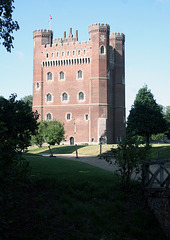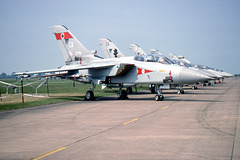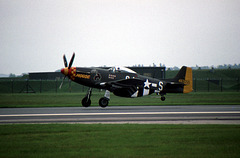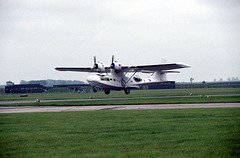Alan Drury's photos
Oban Bay 22nd August 2013
| |
|
St.Columba`s Abbey,Iona 22nd May 1991
| |
|
Iona Abbey is located on the Isle of Iona, just off the Isle of Mull on the West Coast of Scotland. It is one of the oldest and most important religious centres in Western Europe. The abbey was a focal point for the spread of Christianity throughout Scotland and marks the foundation of a monastic community by St. Columba, when Iona was part of the Kingdom of Dál Riata. Iona Abbey is home to the Iona Community, an ecumenical Christian religious order, and remains a popular site of Christian pilgrimage today.
In 1899 the Duke of Argyll transferred ownership of the ruined remains of the Abbey and Nunnery sites to the Iona Cathedral Trust, which undertook extensive restoration of the Abbey church. In 1938, the inspiration of Reverend George MacLeod led a group which rebuilt the abbey, and founded the Iona Community. The reconstruction was organised by the architect Ian Gordon Lindsay having generously been passed the project from his senior mentor and friend Reginald Fairlie. The surrounding buildings were also re-constructed during the 20th century by the Iona Community. This ecumenical Christian community continues to use the site to this day.
The simple square font was added in 1908 and dedicated to the memory of the Very Rev Theodore Marshall DD, Moderator of the General Assembly of the Church of Scotland in that year.[8]
In 2000 the Iona Cathedral Trust handed over the care of the Abbey, Nunnery, and associated sites to Historic Scotland.
Scarborough Harbour from the top of St.Marys Churc…
| |
|
Scarborough (/ˈskɑːrbrə/ or /ˈskɑːrbərə/) is a town on the North Sea coast of North Yorkshire, England. Historically part of the North Riding of Yorkshire, the town lies between 10–230 feet (3–70 m) above sea level, rising steeply northward and westward from the harbour onto limestone cliffs. The older part of the town lies around the harbour and is protected by a rocky headland.
With a population of just over 61,000, Scarborough is the largest holiday resort on the Yorkshire coast. The town has fishing and service industries, including a growing digital and creative economy, as well as being a tourist destination. Inhabitants of the town are known as Scarborians.
Scarborough Castle Keep from St.Marys Church Clock…
| |
|
|
Scarborough Castle is a former medieval Royal fortress situated on a rocky promontory overlooking the North Sea and Scarborough, North Yorkshire, England.The site of the castle, encompassing the Iron Age settlement, Roman signal station, an Anglo-Scandinavian settlement and chapel, the 12th-century enclosure castle and 18th-century battery, is a scheduled monument of national importance.
Fortifications for a wooden castle were built in the 1130s, but the present stone castle dates from the 1150s. Over the centuries, several other structures were added, with medieval monarchs investing heavily in what was then an important fortress that guarded the Yorkshire coastline, Scarborough's port trade, and the north of England from Scottish or continental invasion. It was fortified and defended during various civil wars, sieges and conflicts, as kings fought with rival barons, faced rebellion and clashed with republican forces, though peace with Scotland and the conclusion of civil and continental wars in the 17th century led to its decline in importance.
Once occupied by garrisons and governors who often menaced the town, the castle has been a ruin since the sieges of the English Civil War, but attracts many visitors to climb the battlements, take in the views and enjoy the accompanying interactive exhibition and special events run by English Heritage.
George Square,Glasgow 9th September 2014
| |
|
|
|
Tattershall Castle,Lincolnshire 11th August 2014
| |
|
|
|
Tattershall Castle is a castle in Tattershall, Lincolnshire, England, about 12 miles (19 km) north east of Sleaford. It is in the care of the National Trust.
Tattershall Castle has its origins in either a stone castle or a fortified manor house, built by Robert de Tattershall in 1231.This was largely rebuilt in brick, and greatly expanded, by Ralph, 3rd Lord Cromwell, Treasurer of England, between 1430 and 1450.
Brick castles are less common in England than stone or earth and timber constructions; when brick was chosen as a building material it was often for its aesthetic appeal or because it was fashionable. The trend for using bricks was introduced by Flemish weavers. There was plenty of stone available nearby, but Cromwell chose to use brick. About 700,000 bricks were used to build the castle, which has been described as "the finest piece of medieval brick-work in England".
Of Lord Cromwell's castle, the 130 foot (40 metre) high Great Tower and moat still remain. It is thought that the castle's three state rooms were once splendidly fitted out and the chambers were heated by immense Gothic fireplaces with decorated chimney pieces and tapestries. It has been said that the castle was an early domestic country mansion masquerading as a fortress. Cromwell died in 1456, and the castle was initially inherited by his niece, Joan Bouchier, but it was confiscated by the Crown after her husband's demise. Tattershall Castle was recovered in 1560 by Sir Henry Sidney, who sold it to Lord Clinton, later Earl of Lincoln, and it remained with the Earls of Lincoln until 1693. It passed to the Fortesques,but then fell into neglect.
It was put up for sale in 1910. Its greatest treasures, the huge medieval fireplaces, were still intact. When an American bought them they were ripped out and packaged up for shipping. Lord Curzon of Kedleston stepped in at the eleventh hour to buy the castle and was determined to get the fireplaces back. After a nationwide hunt they were found in London and returned. He restored the castle and left it to the National Trust on his death in 1925. Lord Curzon had undertaken restorations on it between 1911 and 1914. It remains today one of the three most important surviving brick castles of the mid-15th century.
The experience of Tattershall led Lord Curzon to push for heritage protection law in Britain; this was enacted as the Ancient Monuments Consolidation and Amendment Act 1913.
Clyde Puffer The Vital Spark at Iveraray 27th Augu…
| |
|
|
|
The Clyde puffer is a type of small coal-fired and single-masted cargo ship built mainly on the Forth and Clyde canal and which provided a vital supply link around the west coast and Hebrides islands of Scotland. Built between 1856 and 1939, these stumpy little steamboats achieved an almost mythical status thanks largely to the short stories Neil Munro wrote about the Vital Spark and her captain Para Handy, which produced three television series.
Loch Restil near The Rest and be Thankfull 27th Au…
| |
|
|
|
Edinburgh Castle from Princess Street Gardens 26th…
| |
|
|
|
Edinburgh Castle is a historic fortress which dominates the skyline of the city of Edinburgh, Scotland, from its position on the Castle Rock. Archaeologists have established human occupation of the rock since at least the Iron Age (2nd century AD), although the nature of the early settlement is unclear. There has been a royal castle on the rock since at least the reign of David I in the 12th century, and the site continued to be a royal residence until 1633. From the 15th century the castle's residential role declined, and by the 17th century it was principally used as military barracks with a large garrison. Its importance as a part of Scotland's national heritage was recognised increasingly from the early 19th century onwards, and various restoration programmes have been carried out over the past century and a half. As one of the most important strongholds in the Kingdom of Scotland, Edinburgh Castle was involved in many historical conflicts from the Wars of Scottish Independence in the 14th century to the Jacobite Rising of 1745. Research undertaken in 2014 identified 26 sieges in its 1100-year-old history, giving it a claim to having been "the most besieged place in Great Britain and one of the most attacked in the world".
Few of the present buildings pre-date the Lang Siege of the 16th century, when the medieval defences were largely destroyed by artillery bombardment. The most notable exceptions are St Margaret's Chapel from the early 12th century, which is regarded as the oldest building in Edinburgh,the Royal Palace and the early-16th-century Great Hall, although the interiors have been much altered from the mid-Victorian period onwards. The castle also houses the Scottish regalia, known as the Honours of Scotland and is the site of the Scottish National War Memorial and the National War Museum of Scotland. The British Army is still responsible for some parts of the castle, although its presence is now largely ceremonial and administrative. Some of the castle buildings house regimental museums which contribute to its presentation as a tourist attraction.
The castle, in the care of Historic Scotland, is Scotland's most-visited paid tourist attraction, with over 1.4 million visitors in 2013.As the backdrop to the Edinburgh Military Tattoo during the annual Edinburgh International Festival the castle has become a recognisable symbol of Edinburgh and of Scotland and indeed, it is Edinburgh's most frequently visited visitor attraction—according to the Edinburgh Visitor Survey, more than 70% of leisure visitors to Edinburgh visited the castle.
The Bridge Scottish Icon 26th August 2016
| |
|
|
|
The Forth Bridge is a cantilever railway bridge over the Firth of Forth in the east of Scotland, 9 miles (14 kilometres) west of Edinburgh City Centre. It is considered an iconic structure and a symbol of Scotland, and is a UNESCO World Heritage Site. It was designed by the English engineers Sir John Fowler and Sir Benjamin Baker.
Construction of the bridge began in 1882 and it was opened on 4 March 1890 by the Prince of Wales, the future Edward VII.The bridge spans the Forth between the villages of South Queensferry and North Queensferry and has a total length of 8,094 feet (2,467 m). It was the longest single cantilever bridge span in the world until 1917 when the Quebec Bridge in Canada was completed. It continues to be the world's second-longest single cantilever span.
The bridge and its associated railway infrastructure are owned by Network Rail Infrastructure Limited.
It is sometimes referred to as the Forth Rail Bridge to distinguish it from the Forth Road Bridge, though this has never been its official name.
View of Loch Long from The Ardgartan Hotel 26th Au…
| |
|
|
|
Loch Long (Gaelic for Ship Lake, Long being the word for ship) is a body of water in Argyll and Bute, Scotland. The sea loch extends from the Firth of Clyde at its southwestern end. It measures approximately 20 miles (32 km) in length, with a width of between 1 and 2 miles (1.6 and 3.2 km). The loch also has an arm, Loch Goil, on its western side.
Loch Long was historically the boundary between Argyll and Dunbartonshire. However, in 1996 boundary redrawing meant that it moved wholly within the council area of Argyll and Bute.
The loch was used as a testing ground for torpedoes during World War II and contains numerous wrecks. It is now a popular area for sport diving. The Ardentinny Outdoor Education Centre also uses the loch for watersports.
Several Scottish sea fishing records are attributed to the loch:
The RAF Aerobatic Display Team The Red Arrows line…
| |
|
|
|
Panavia Tornado line up at RAF Coningsby 16th June…
| |
|
|
|
North American P-51D Mustang touching down at RAF…
| |
|
|
|
Lockheed C130 Hercules flying over Seamer Carr Far…
| |
|
|
The Lockheed C-130 Hercules is a four–engined turboprop military transport aircraft designed and built originally by Lockheed (now Lockheed Martin). Capable of using unprepared runways for takeoffs and landings, the C-130 was originally designed as a troop, medevac, and cargo transport aircraft. The versatile airframe has found uses in a variety of other roles, including as a gunship (AC-130), for airborne assault, search and rescue, scientific research support, weather reconnaissance, aerial refueling, maritime patrol, and aerial firefighting. It is now the main tactical airlifter for many military forces worldwide. Over forty variants and versions of the Hercules, including a civilian one marketed as the Lockheed L-100, operate in more than 60 nations.
The C-130 entered service with the U.S. in the 1950s, followed by Australia and others. During its years of service, the Hercules family has participated in numerous military, civilian and humanitarian aid operations. In 2007, the C-130 became the fifth aircraft—after the English Electric Canberra, B-52 Stratofortress, Tu-95 Bear, and KC-135 Stratotanker—to mark 50 years of continuous service with its original primary customer, in this case, the United States Air Force. The C-130 Hercules is the longest continuously produced military aircraft at over 60 years, with the updated Lockheed Martin C-130J Super Hercules being produced today.
Consolidated PBY-5A Catalina landing at RAF Waddin…
| |
|
The Consolidated PBY Catalina, also known as the Canso in Canadian service, was an American flying boat, and later an amphibious aircraft of the 1930s and 1940s produced by Consolidated Aircraft. It was one of the most widely used seaplanes of World War II. Catalinas served with every branch of the United States Armed Forces and in the air forces and navies of many other nations.
During World War II, PBYs were used in anti-submarine warfare, patrol bombing, convoy escorts, search and rescue missions (especially air-sea rescue), and cargo transport. The PBY was the most numerous aircraft of its kind and the last active military PBYs were not retired from service until the 1980s. In 2014, nearly 80 years after its first flight, the aircraft continues to fly as a waterbomber (or airtanker) in aerial firefighting operations all over the world.
British Airways Concord at RAF Finningley 23rd Sep…
| |
|
|
|
Boeing B-17G Flying Fortress Sally .B at Alconbury…
| |
|
|
|


















